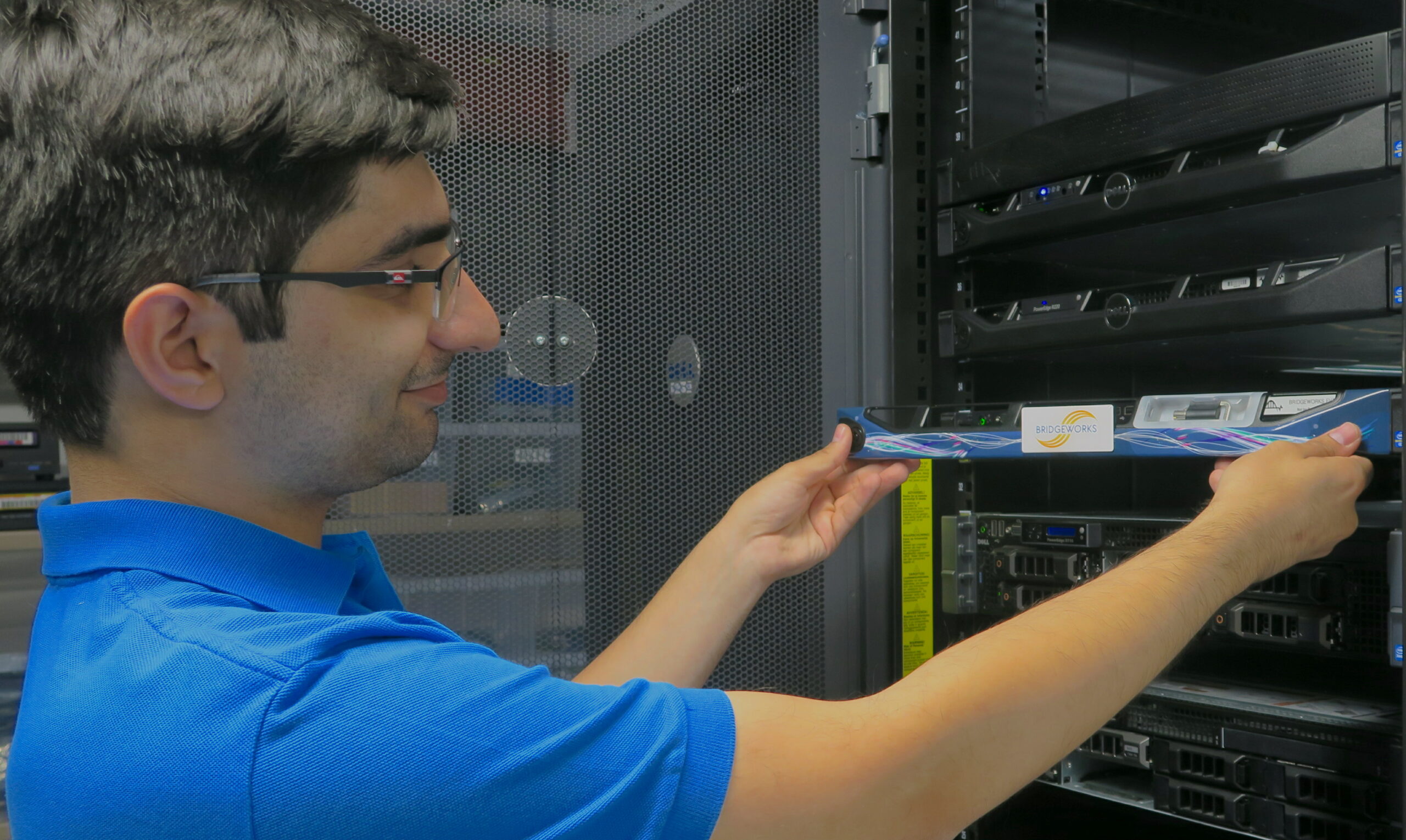Bridgeworks CEO, David Trossell features in Health Tech World Magazine about the advances in digital transformation revolutionising the healthcare industry during a pandemic.

October 20, 2021
The COVID-19 pandemic has touched every part of society, pushing forward the drive for digital transformation to the extent that even hospitals and healthcare organisations now need to follow a digital-first strategy.
Michael D. Robinson, Vice President, Healthcare North America at VMware, argues in his article ‘Why the Digital-First, Patient-Centered Care is Critical to Healthcare’ for HIT Consultant that the pandemic is the tipping point towards healthcare being digital-first. With this drive, comes the need to have fast, efficient, secure and effective networking, with data at the centre of its success or failure.
Hype or reality?
However, David Trossell, CEO and CTO of Bridgeworks, questions whether the talk about ‘digital-first’ healthcare is more part of the latest hype cycle, rather than actual reality in terms of being a completely new approach. He asks: “…because of the pandemic and everyone isolating, we’ve seen the expansion of telephone consultation and now the use of video clinical appointments; But, has it changed the underlying way of how health data is collected, analysed and utilised?”
Responding to his own question, he remarks: “From a personal point of view, I can now order repeat prescriptions, check up on blood tests and book an electronic appointment from a web portal. However, I still get appointments through the post. What I don’t understand is the need for me to provide two phone numbers: one mobile so they can send me text messages and an email address if they don’t use them.”
He therefore believes that there is still a long way to go on the “digital-first pathway”. To become truly digital first, there is a need to solve the data problem first. Trossell explains that this begins with the data being up-to-date because data input and analysis has to occur contemporaneously these days – effectively in real-time in order to achieve and maintain data accuracy.
No organisation wants to flounder on the old adage and circumstance of “garbage in, garbage out”, which is a costly modus operandi in terms of finance and with regard to the ability to deliver the right outcomes for customers – including for patients. Reputations can be affected by poor quality data and, in healthcare terms, a mistaken diagnosis could be lethal.
Role for AI
With data volumes increasing exponentially with the pursuit of digital transformation, he therefore thinks healthcare organisations will employ more artificial intelligence (AI) to check the validity of the entry. Having too much data can create much noise and having too little data could prevent an accurate diagnosis and subsequent treatment. The underlying cause of a medical condition might also be missed, which could prevent clinicians from acting to treat a disease or medical condition before it occurs.
Trossell adds that data should both be available and accessible: “Data should be available, no matter where it’s required. We have hospitals, doctors, nurses and GPs with access to clinical data. However, with modern telecoms and now low earth orbit satellites, it should be possible to have access anywhere in the world on any platform.”
He also suggests questions should be asked about who the beneficiary of the data is: “Many people now think that they need to take matters into their own hands, as access to clinicians is becoming more difficult – don’t make the system just for the medical staff, but for the patient as well.
“The key aspect of digital-first healthcare is that it must be patient-centred. It’s not just a technology project. “It’s not a question of whether digital-first strategy will continue because it has to. We have started this process, and so it has to continue otherwise the burden on clinical staff going forward will cause the system to collapse”, he suggests.
Robinson comments: “Change is everywhere in the healthcare industry. In the past, it may have been criticised for not readily adopting new technologies. Now, according to findings from a study conducted by MIT Technology Review Insights, that’s no longer the case. The study found 89 per cent of healthcare executives are accelerating their digital transformation efforts. Close to half (44 per cent) anticipate budget increases and more than half (51 per cent) are increasing investments in the patient experience.”
He also believes that a digital-first healthcare approach is now a permanent fixture: “The pandemic is driving change, and regulations have been relaxed to allow for safe, remote tele-health opportunities. According to a recent McKinsey report, consumer adoption of tele-health has skyrocketed, from 11 per cent of US consumers, using the technology in 2019 to 46 per cent in 2020, to replace canceled healthcare visits. The report also found providers are seeing 50 to 175 times the number of patients via telehealth than before.”
Patients first
Trossell agrees that patients have to remain foremost at the centre of healthcare, in order for the strategy to work. He explains: “Like many of the traditional methods we’ve used for interacting digitally with government, and large institutions like banks and insurance companies have all gone digital. The population, especially the younger generations, now expect it too.”
There are nevertheless, in his opinion, some issues to resolve. Security is but one of them, as even hospitals have faced the onslaught of ransomware attacks. Furthermore, many outpatient and inpatient appointments are still sent by post. Yet, he says there has been a significant increase in the use of medical records apps, which he thinks may be a way forward to provide a secure interface.
He explains: “From the patient point of view, we can see a small part of our medical records, which raises another question: who owns your medical data? The State, the healthcare and medical provider, or ourselves as individual patients?” There also must be consideration to who has access to patients’ medical records for their own healthcare, and for medical research.
“There is a new bill going through the UK parliament that allows the police access to medical records’, he says, before asking: “What medical records are part of a patient-first, data-second or a data-first, patient-second strategy?” He adds: “Without the right controls, this could become a minefield of legislation.”
Data purposes
With all the data that is now available, forethought is needed to put it into good use. That requires some consideration of the ethics around its use by third parties. He also suggests: “Large-scale medical data can be put to such good use with modern data mining and AI. These can be huge data sets and getting them to research and involving other medical institutions can give us insights that once were thought to be impossible. But we still have to get the data to these instructions and work out a way we do that efficiently, easily and securely.”
Top digital-first tips
Here are Trossell’s top digital first tips:
- Make sure everyone up and down the digital food chain buys into it.
- Remember to use the right technology in the right hands to access the information, such as SD-WANs with a WAN Acceleration overlay.
- Share data across the disciplines – no siloed data.
- Apply data interchange standards
- Ensure security – people have to trust that their data is being protected.
He advises healthcare providers to tackle data security first: “The internet is a wonderful thing’, but it is not secure”, he stresses. This means there is a need to find a secure way to transmit, receive, back up and store valuable healthcare and medical data. This solution must allow for the rapid setting up of secure dedicated networks over the internet, with the capability to also take them down instantly, according to circumstance and demand.
Overlays accelerate data
Trossell finds that SD-WANs are perfect for this functionality. Nevertheless, he adds: “If we have a need to move vast amounts of data across longer distances when WANs and data are at the mercy of network packet loss and latency, which destroy and performance, there is a need for WAN Acceleration to come into play.”This technology, he says, can augment the SD-WAN by mitigating the effects of latency and packet loss. Furthermore, the key feature of WAN Acceleration is the ability to accelerate encrypted data without changing the data.Utilising these technologies can provide the fast, safe data transfer requirements, while enhancing a digital-first healthcare strategy that puts patients first at its core.
Click here to read the article on Health Tech World Magazine




